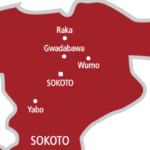It is a peasant community known relatively for farming and fishing activities and lacks most basic amenities like health care centre, access road, electricity, pipe-borne water amongst others until the United Nations Environment Programme released a report that many states in Nigeria were under threat from Lake Nyos in the Cameroon.
The scientists from UNEP predicted a possible collapse of the volcanic lake and that water, stones, trees and other items that would be picked on the way as the water rushes out have the potential of causing collateral damage in seven states of the federation.
As a way of protecting Nigerians from the impact of the lake, the federal government conceived the idea of a buffer dam and this led to the award and commencement of work at the ongoing Kashimbilla multipurpose dam.
The community leader of Kashimbilla District, Mr. John Dio Kan, said the project which was borne out of adversity has turned into an opportunity that has brought about meaningful development in the community.
According to him, when the project started a lot of people were not in support but with the development it has brought, everybody wants to identify with it from within the community and even outside.
Kashimbilla multipurpose dam was initially conceived to serve as a buffer against the imminent flood that will occur as a result of the collapse of the upper reaches of Lake Nyos which is situated up in the hills of Cameroun, upstream of Kashimbilla River.
In 1986 there was an eruption there that triggered the release of about 1.6 million tonnes of carbon dioxide – around a cubic kilometre of the gas flowed from the mountain into the two populated valleys below. The gas displaced all the air, suffocating 1,800 people and 3500 livestock. Of the 4,000 inhabitants who fled the valleys, many developed respiratory problems, burns and even paralysis from the gas.
A report made available to Daily Trust by the Ministry of Water Resources reveals that the contract for the dam was awarded in May 2007 to SCC (Nigeria) Ltd to be completed within 36 months (April, 2014) but later revised to March, 2015 due to the expansion of the project to accommodate other needs.
It states that the initial sum for the project was N42 billion and revised to N60 billion and later to N104 billion. The dam construction has gulped about a billion dollars according to the Minister of Water Resources, Mrs. Sarah Reng Ochekpe, and is at about 87 percent completion stage.
It was gathered that the project was divided into phases, including the construction of multi-purpose dam which is to serve as a control measure to contain overflow of water should the Lake Nyos fail, construction of water treatment plant, access road, hydro-power plant with the capacity of generating 40mw of electricity, air strip, irrigation network, staff housing units and pipeline for water conveyance to Takum town and environs.
However, it was gathered by Daily Trust that the mini air strip has been completed and it is expected to serve as a fast link to the community for evacuation should the lake break before completion.
Speaking to Daily Trust, the Project Manager, Engr. Michael Robin, said the dam on completion would impound 500 million cubic meters of water from the Lake Nyos and is built with the potential of generating about 40 megawatts of power. It also provides 3000 hectares for irrigation and water supply to Takum which is about 25 kilometres while maximising the potential in Kashimbilla.
He added that the dam would also serve as a source of potable water supply to surrounding communities and, also importantly, it would eliminate the fear of flooding once it is completed as it will retain the water and release it harmlessly.
Engr. Robin said the project was being expanded to accommodate other things and to ensure that it is a worthwhile venture for the government and the people.
According to him, a 22km access road has been constructed, in addition of 11km access road from the initial plan; about six solar powered boreholes constructed in Jato Aka and handed over to the communities; a police out station built to safeguard the people and two ATM machines that are attracting many people from different communities to Kashimbilla.
He stated that plans have been concluded to incorporate tourist centre into the project which has attained over 80 percent in structures.
However, he noted that the timely release of fund would help to complete the project as expected; “despite the fact that work is still ongoing, the pace of work is being slowed because of fund.”
Engr. Stephen Jalo, the Chief Resident Engineer for the project said the community accepted the work because it has created lots of opportunities in terms of employment, many of the youth have been empowered through the project.
He said the benefit of the project is enormous, as apart from saving the community from danger, it also provides an enabling environment for them to secure and earn their livelihood.
According to him, the generation of 40 megawatts of electricity would go a long way in solving the problem of power in the area because it will supply light to the local community and reduce the dependence on the national grid.
Mr. Dio Kan speaking on the project said members of the host community are quite impressed with the work done so far and expressed appreciation to Mr President who took up the project after they thought it had been abandoned.
“We are going to be the first community to benefit from the project and we will be the first victim as well if the Lake Nyos breaks,” he said.
“Looking at the project, you cannot get the benefit immediately, but let us look at the future,” he said.
Speaking on the issue of compensation and resettlement, he said some communities have been compensated while others have not and they will not stop construction work on the dam till they get money because the dam is to save lives.
“We are people living under Kashimbilla district. In such a situation, when we say let them stop the work and it happens that Lake Nyos breaks, the community and about other six states will be affected, so we said they should exercise patience and we talked to the government to see our plight. Eventually, they paid some people and some are yet to be paid,” he said.
He said there was a time the people wanted to protest to stop the work but as leaders they found a way of calming them down.
On the issue of settlement, he said: “We are not settled because the time we were supposed to get the money that will enable us construct our huts to move, they didn’t pay us on time but kept differing the date of payment.
“The money paid to our people was around August and for now it is not sufficient to settle us because we used some to buy building materials and some to do construction of huts and some to maintain ourselves and it is the rainy season now. We cannot do anything until the rain stops.”
The 76-year-old community leader noted that River Katsina-Ala which passes through Kashimbilla had never overflowed its banks since he was a kid in the village but added that the threat of Lake Nyos was beyond their comprehension hence the need to co-operate with government on the building of the dam.
Mr Dio Kan, therefore appealed to government to intensify efforts on the issue of resettlement by clearing the land before the rains stop to enable them resettle as quick as possible.
Plight of the communities
In a letter addressed to NEMA by the Concerned Communities Forum (CCF) of Kashimbilla and made available to Daily Trust, the communities noted that compensation has so far been paid to Birama, Birama Zambana, Gidan Loan, Gamuvo 1, 2 & 3, Yirikum 1, 2 &3, Zankyapa 1&2,and Alang community, adding that while the above communities were indeed compensated, the only access route connecting Shibong Igbang, Lukpo, Gamga, Bariki Lissa, Liji, Gidan Don, Lutu, Lanke, and Manga villages to the local government headquarters would be submerge by water soon as the water volume keeps increasing and therefore the need to reconnect these communities has become imperative.
The forum also seeks for quick intervention by the federal government to expedite action on payment of compensation to the remaining affected communities of Lanke, Shibong Igbang, Gidan Don, Manga, Gidan Samba, Gidan Umaru, Mgbe, Shidawa, Baka, Gidan Abershi, Gidan Bala and others.
As the communities await compensation which the ministry of water resources said it was working out in phases, residents of Kashimbilla can now sleep with both eyes closed as at least the envisaged impact of Lake Nyos which on breakage will flow into Nigeria after six hours at a height of 11.38m, an equivalent of the height of a three-storey building, would have been drastically reduced by the dam and all associated dangers with any breakage of the lake brought to the barest minimum.
 Join Daily Trust WhatsApp Community For Quick Access To News and Happenings Around You.
Join Daily Trust WhatsApp Community For Quick Access To News and Happenings Around You.


